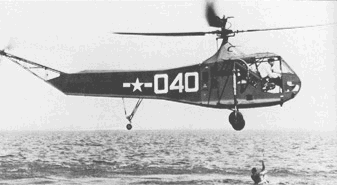 Return to
Return toAviation Answer-Man
Gateway
 Return to
Return to
Aviation Answer-Man
Gateway
 Return to
Return to.
Chapter 7
The
Sikorsky R-4 Helicopter
Copyright 2000, 2001, 2002 by Richard Harris
All Rights Reserved
 This is THE helicopter that started it all. The first successful, mass-production helicopter, the Sikorsky R-4 (right) made vertical flight an actual, attainable human possibility -- making virtually every place on earth accessible to an aircraft.
This is THE helicopter that started it all. The first successful, mass-production helicopter, the Sikorsky R-4 (right) made vertical flight an actual, attainable human possibility -- making virtually every place on earth accessible to an aircraft.
 The R-4 grew out of Russian-American immigrant Igor Sikorsky's awkward-looking, open-cockpit "V-300" experimental prototype, (left). Though the V300 introduced Sikorsky's basic design concept, it was the R-4 -- Sikorsky's first production model -- that would become the first truly useable, practical helicopter.
The R-4 grew out of Russian-American immigrant Igor Sikorsky's awkward-looking, open-cockpit "V-300" experimental prototype, (left). Though the V300 introduced Sikorsky's basic design concept, it was the R-4 -- Sikorsky's first production model -- that would become the first truly useable, practical helicopter.
In a time when other experimenters were building helicopters in a bizarre variety of configurations, sometimes with two or even three main rotors, Sikorsky's design was sophisticated enough to lift itself with one rotor, with thoroughly-controlled flight -- only lightly assisted by a small "tail rotor." The R-4 featured a single main rotor, with a tail boom supporting a single, small, side-facing "anti-torque" rotor, to couteract the helicopter's natural tendency to revolve in the opposite direction from the main rotor.
 Varying the pitch of the anti-torque rotor (with rudder pedals, as on a plane) allowed pilots to precisely aim the helicopter in any direction. A combination of main-rotor "collective pitch" control and throttle allowed the pilot to regulate thrust and lift, while a conventional pilot's joystick allowed the pilot to control the tilt (nose-up/nose-down "pitch" and left/right "roll") of the rotor "disk" (the whirling blades of the main rotor). Controlling the tilt of the rotor disk let the pilot control forward, backward and sideways movement of the helicopter.
Varying the pitch of the anti-torque rotor (with rudder pedals, as on a plane) allowed pilots to precisely aim the helicopter in any direction. A combination of main-rotor "collective pitch" control and throttle allowed the pilot to regulate thrust and lift, while a conventional pilot's joystick allowed the pilot to control the tilt (nose-up/nose-down "pitch" and left/right "roll") of the rotor "disk" (the whirling blades of the main rotor). Controlling the tilt of the rotor disk let the pilot control forward, backward and sideways movement of the helicopter.
Additional features integrated into the complex rotor hub accomodated the complex and intense competing forces of thrust, centrifugal force, gyroscopic precession, differential drag and lift in forward flight, and inherent flexing tendencies of the entire rotor -- forces that tended to hobble countless previous designs -- or lead to their catastrophic self-destruction.
While only a few R-4's were built, the R-4 became the defining helicopter model for the 20th century. And most successful helicopters today still follow the Sikorsky model.
The R-4 was developed too late to be truly useful in World War II, but its successors have played important roles in every American war since, and in many others. The helicopter has taken over military close air support missions ("Army Aviation") from the Cub and other fixed-wing aircraft, as well as countless utility and emergency-services uses worldwide. Chiefly these have been models built on the Sikorsky design -- and later Sikorskys (virtually all pattered on the original R-4 concept) have continued as one of the three dominant families in American rotorcraft. The modern helicopter, with its high degree of maneuverability and control, permits flying into (and out of) places that no other type of aircraft can reach. Whether lifting an artillery piece to a high mountain ridge, or hoisting an antenna to the top of a skyscraper, the helicopter's particular value has been its singular ability to put anything (or anyone) anywhere, anytime.
 Though its best-known exploits are at war, perhaps the helicopter's greatest accomplishment is its ability to save lives. During the Korean and Vietnam Wars, when helicopters became widely available to whisk wounded to the nearest field hospital, U.S. Army officials discovered that helicopter medical evacuation ("Helo Med-Evac") radically increased the soldier's chance of surviving his wounds, with the result that serious American casualties had a far lower death rate in Vietnam than in any war before. That technology has been brought home to the U.S., where helicopter ambulances are now a routine asset for treating the critically ill and injured -- particularly where great distances or difficult terrain separate the victim from emergency facilities.
Though its best-known exploits are at war, perhaps the helicopter's greatest accomplishment is its ability to save lives. During the Korean and Vietnam Wars, when helicopters became widely available to whisk wounded to the nearest field hospital, U.S. Army officials discovered that helicopter medical evacuation ("Helo Med-Evac") radically increased the soldier's chance of surviving his wounds, with the result that serious American casualties had a far lower death rate in Vietnam than in any war before. That technology has been brought home to the U.S., where helicopter ambulances are now a routine asset for treating the critically ill and injured -- particularly where great distances or difficult terrain separate the victim from emergency facilities.
Today, half a century after its development, the R-4's legacy lives on in thousands of helicopters worldwide -- used in every human activity imaginable, from military warfare to recreational sightseeing, construction, agriculture, forestry, law-enforcement, firefighting, med-evac, short-haul passenger airlines, exploration, offshore oil drilling, search-and-rescue, business travel, cargo hauling and more. And -- almost always -- the helicopter performing the mission is built along the basic main-rotor-and-tail-rotor Sikorsky design configuration -- first put to use, successfully, in the Sikorsky R-4.
Why this aircraft stands out from its "peers."
While many other aircraft have been important, few (if any) others had nearly so pivotal an impact on aviation or on the instant reach of human hands as the Sikorsky R-4 Helicopter . This aircraft is an "indispensible"aircraft to aviation history and to the world -- an aircraft with no significant concievable substitute available at their juncture in history.
Lots tried and lots died. Helicopters were still a risky, screwy bunch of machines when the R-4 was created. The Sikorsky R-4 was the first stable, truly-maneuverable, reliable, affordable, practical helicopter. While Piasecki, Kaman, Mil and others were well on their way to creating viable helicopters, none had so efficient, flexible and effective a design. Piasecki's tandem-rotor helicopters proved impractical for any but the biggest-sized helicopters, while Kaman's concept offered less-than-blazing performance.
And -- though ahead of much of the rest of the world -- Russian designers like Mil were generally a step behind America's prolific creativity, and sophisticated craftsmanship, in rotorcraft design. Sikorsky's two previous aviation careers -- as the pioneer of big planes (while in his native Czarist Russia), and as the dean of the world's flying boat designers of the 1930's -- provided him with the aeronautical engineering and manufacturing experience to see the whole scope of aircraft development issues with greater depth and clarity than his competitors. While they remained all-too-fascinated with exotic theories and clever ideas, Igor Sikorsky remained focused on practical design, and marched steadily towards to the first practical helicopter.
Most other helicopter designs of the 1940's would seem flaky today, in light of our experience with the basic, efficient, flexible design which Sikorsky developed to practicality. It is the basic design used on almost all of the world's helicopters to this day. While some historians prefer to credit the first flying example of Sikorsky's technology -- the VS-300 -- as the greatest helicopter, it was only a concept-demonstration prototype, lacking essential practical features -- including an enclosed cockpit. Other concept prototypes had flown about the same time, and some were surprisingly plausible, and would lead to subsequent production aircraft. But the R-4 beat them to the market, and shaped it.
The R-4 was the first COMPLETE helicopter, ready for serious missions. Consequently, it became the defining helicopter design of the 20th Century. No helicopter since then has had nearly so great an influence on helicopter design. None.
 Return to
Return to
 Return to
Return to
Aviation Answer-Man
Gateway